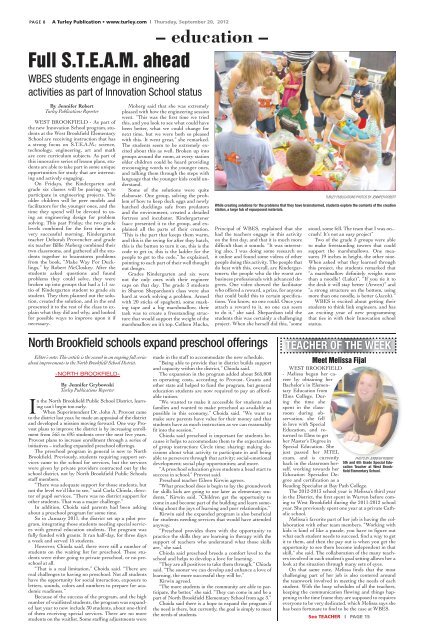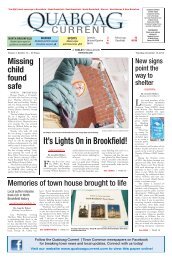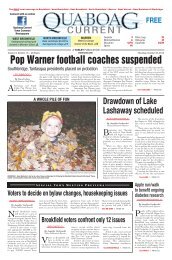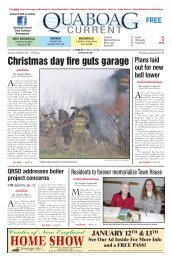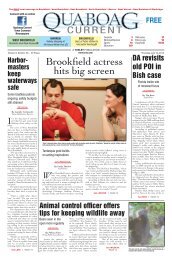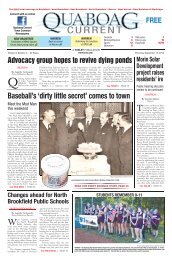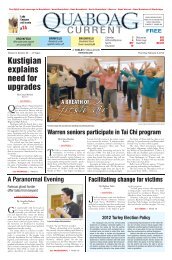September 20, 2012 pdf edition - Quaboag Current
September 20, 2012 pdf edition - Quaboag Current
September 20, 2012 pdf edition - Quaboag Current
You also want an ePaper? Increase the reach of your titles
YUMPU automatically turns print PDFs into web optimized ePapers that Google loves.
PAGE 8 A Turley Publication • www.turley.com I Thursday, <strong>September</strong> <strong>20</strong>, <strong>20</strong>12<br />
– education –<br />
Full S.T.E.A.M. ahead<br />
WBES students engage in engineering<br />
activities as part of Innovation School status<br />
By Jennifer Robert<br />
Turley Publications Reporter<br />
WEST BROOKFIELD - As part of<br />
the new Innovation School program, students<br />
at the West Brookfi eld Elementary<br />
School are receiving instruction that has<br />
a strong focus on S.T.E.A.M.; science,<br />
technology, engineering, art and math<br />
are core curriculum subjects. As part of<br />
this innovative series of lesson plans, students<br />
are able to take part in some unique<br />
opportunities for study that are interesting<br />
and actively engaging.<br />
On Fridays, the Kindergarten and<br />
grade six classes will be pairing up to<br />
participate in engineering projects. The<br />
older children will be peer models and<br />
facilitators for the younger ones, and the<br />
time they spend will be devoted to using<br />
an engineering design for problem<br />
solving. This past Friday, the two grade<br />
levels combined for the fi rst time in a<br />
very successful morning. Kindergarten<br />
teacher Deborah Provencher and grade<br />
six teacher Billie Moberg combined their<br />
two classrooms, and gathered all the students<br />
together to brainstorm problems<br />
from the book, “Make Way For Ducklings,”<br />
by Robert McCloskey. After the<br />
students asked questions and found<br />
problems they could solve, they were<br />
broken up into groups that had a 1:1 ratio<br />
of Kindergarten student to grade six<br />
student. They then planned out the solution,<br />
created the solution, and in the end<br />
presented it to the rest of the class to explain<br />
what they did and why, and looked<br />
for possible ways to improve upon it if<br />
necessary.<br />
Moberg said that she was extremely<br />
pleased with how the engineering session<br />
went. “This was the fi rst time we tried<br />
this, and you look to see what could have<br />
been better, what we could change for<br />
next time, but we were both so pleased<br />
with this. It went great,” she remarked.<br />
The students seem to be extremely excited<br />
about this as well. Broken up into<br />
groups around the room, at every station<br />
older children could be heard providing<br />
encouraging words to the younger ones,<br />
and talking them through the steps with<br />
language that the younger kids could understand.<br />
Some of the solutions were quite<br />
elaborate. One group, solving the problem<br />
of how to keep duck eggs and newly<br />
hatched ducklings safe from predators<br />
and the environment, created a detailed<br />
fortress and incubator. Kindergartener<br />
Isacc presented it to the group, and explained<br />
all the parts of their creation.<br />
“This is the part that keeps them warm,<br />
and this is the swing for after they hatch,<br />
this is the button to turn it on, this is the<br />
code to get in, this is the ladder for the<br />
people to get to the code,” he explained,<br />
pointing to each part of their well thought<br />
out design.<br />
Grades Kindergarten and six were<br />
not the only ones with their engineer<br />
caps on that day. The grade 3 students<br />
in Sharon Shepardson’s class were also<br />
hard at work solving a problem. Armed<br />
with <strong>20</strong> sticks of spaghetti, some masking<br />
tape and a big marshmallow, their<br />
task was to create a freestanding structure<br />
that would support the weight of the<br />
marshmallow on it’s top. Colleen Mucha,<br />
TURLEY PUBLICATIONS PHOTOS BY JENNIFER ROBERT<br />
While creating solutions for the problems that they have brainstormed, students explore the contents of the creation<br />
station, a large tub of repurposed materials.<br />
Principal of WBES, explained that she<br />
had the teachers engage in this activity<br />
on the fi rst day, and that it is much more<br />
diffi cult than it sounds. “It was interesting<br />
also, I was doing some research on<br />
it online and found some videos of other<br />
people doing this activity. The people that<br />
do best with this, overall, are Kindergarteners;<br />
the people who do the worst are<br />
business professionals with advanced degrees.<br />
One video showed the facilitator<br />
who offered a reward, a prize, for anyone<br />
that could build this to certain specifi cations.<br />
You know, no one could. Once you<br />
attach a reward to it, no one can seem<br />
to do it,” she said. Shepardson told the<br />
students this was certainly a challenging<br />
project. When she herself did this, “some<br />
North Brookfi eld schools expand preschool offerings<br />
Editor’s note: This article is the second in an ongoing fall series<br />
about improvements to the North Brookfi eld School District.<br />
-NORTH BROOKFIELD-<br />
By Jennifer Grybowski<br />
Turley Publications Reporter<br />
In the North Brookfi eld Public School District, learning<br />
can’t begin too early.<br />
When Superintendent Dr. John A. Provost came<br />
to the district last year, he made an appraisal of the district<br />
and developed a mission moving forward. One way Provost<br />
plans to improve the district is by increasing enrollment<br />
from 565 to 695 students over the next fi ve years.<br />
Provost plans to increase enrollment through a series of<br />
initiatives – including expanded preschool offerings.<br />
The preschool program in general is new to North<br />
Brookfi eld. Previously, students requiring support services<br />
came to the school for services, but the services<br />
were given by private providers contracted out by the<br />
school district, not by North Brookfi eld Public Schools<br />
staff members.<br />
“There was adequate support for those students, but<br />
not the level we’d like to see,” said Carla Chioda, director<br />
of pupil services. “There was no district support for<br />
other students. That was a major challenge.”<br />
In addition, Choida said parents had been asking<br />
about a preschool program for some time.<br />
So in January <strong>20</strong>11, the district set up a pilot program,<br />
integrating those students needing special services<br />
with general education students. The program was<br />
fully funded with grants. It ran half-day, for three days<br />
a week and served 15 students.<br />
However, Chioda said, there were still a number of<br />
students on the waiting list for preschool. These students<br />
were either going to private preschool, or no preschool<br />
at all.<br />
“That is a real limitation,” Choida said. “There are<br />
real challenges to having no preschool. Not all students<br />
have the opportunity for social interaction, exposure to<br />
letters, sounds, colors and numbers to prepare for academic<br />
readiness.”<br />
Because of the success of the program, and the high<br />
number of waitlisted students, the program was expanded<br />
last year to now include 30 students, about one-third<br />
of them receiving special services. There are no more<br />
students on the waitlist. Some staffi ng adjustments were<br />
made in the staff to accommodate the new schedule.<br />
“Being able to provide that in district builds support<br />
and capacity within the district,” Chioda said.<br />
The expansion in the program added about $65,000<br />
in operating costs, according to Provost. Grants and<br />
other state aid helped to fund the program, but general<br />
education students are now required to pay an affordable<br />
tuition.<br />
“We wanted to make it accessible for students and<br />
families and wanted to make preschool as available as<br />
possible in this economy,” Choida said. “We want to<br />
make sure parents have value for their money and that<br />
students have as much instruction as we can reasonably<br />
fi t into the session.”<br />
Chioda said preschool is important for students because<br />
it helps to accommodate them to the expectations<br />
of group instruction: Circle time; sharing; making decisions<br />
about what activity to participate in and being<br />
able to persevere through that activity; social-emotional<br />
development; social play opportunities; and more.<br />
“A preschool education gives students a head start to<br />
success in school,” Provost said.<br />
Preschool teacher Eileen Kirwin agrees.<br />
“What preschool does is begin to lay the groundwork<br />
for skills kids are going to use later as elementary students,”<br />
Kirwin said. “Children get the opportunity to<br />
come in and become part of the building and learn something<br />
about the joys of learning and peer relationships.”<br />
Kirwin said the expanded program is also benefi cial<br />
for students needing services that would have attended<br />
anyway.<br />
“Preschool provides them with the opportunity to<br />
practice the skills they are learning in therapy with the<br />
support of teachers who understand what those skills<br />
are,” she said.<br />
Chioda said preschool breeds a comfort level to the<br />
school and helps to develop a love for learning.<br />
“They are all positives to take them through,” Chioda<br />
said. “The sooner we can develop and enhance a love of<br />
learning, the more successful they will be.”<br />
Kirwin agreed.<br />
“The more students in the community are able to participate,<br />
the better,” she said. “They can come in and be a<br />
part of North Brookfi eld Elementary School from age 3.”<br />
Choida said there is a hope to expand the program if<br />
the need is there, but currently, the goal is simply to meet<br />
the needs of students.<br />
stood, some fell. The team that I was on...<br />
crash! It’s not an easy project”<br />
Two of the grade 3 groups were able<br />
to make freestanding towers that could<br />
support the marshmallows. One measures<br />
19 inches in height, the other nine.<br />
When asked what they learned through<br />
this project, the students remarked that<br />
“a marshmallow defi nitely weighs more<br />
than a noodle! (Luke)”, “If you tie it to<br />
the desk it will stay better (Arwen)” and<br />
“a strong structure on the bottom, using<br />
more than one noodle, is better (Jacob).”<br />
WBES is excited about getting their<br />
students to think link engineers, and has<br />
an exciting year of new programming<br />
that ties in with their Innovation school<br />
status.<br />
TEACHER OF THE WEEK<br />
Meet Melissa Fijal<br />
WEST BROOKFIELD<br />
- Melissa began her career<br />
by obtaining her<br />
Bachelor’s in Elementary<br />
Education from<br />
Elms College. During<br />
the time she<br />
spent in the classroom<br />
during observation,<br />
she fell<br />
in love with Special<br />
Education, and returned<br />
to Elms to get<br />
her Master’s Degree in<br />
Special Education. She<br />
just passed her MTEL<br />
exam, and is currently<br />
back in the classroom herself,<br />
working towards her<br />
Education Specialist Degree<br />
and certifi cation as a<br />
Reading Specialist at Bay Path College.<br />
PHOTO BY JENNIFER ROBERT<br />
5th and 6th Grade Special Education<br />
Teacher at West Brookfi<br />
eld Elementary School.<br />
The <strong>20</strong>12-<strong>20</strong>13 school year is Melissa’s third year<br />
in the District, the fi rst spent in Warren before coming<br />
to West Brookfi eld during the <strong>20</strong>11-<strong>20</strong>12 school<br />
year. She previously spent one year at a private Catholic<br />
school.<br />
Melissa’s favorite part of her job is having the collaboration<br />
with other team members. “Working with<br />
kids is kind of like a puzzle, you have to fi gure out<br />
what each student needs to succeed, fi nd a way to get<br />
it to them, and then the pay out is when you get the<br />
opportunity to see them become independent in that<br />
skill,” she said. The collaboration of the many teachers<br />
involved in each student’s goal setting allows her a<br />
look at the situation through many sets of eyes.<br />
On that same note, Melissa fi nds that the most<br />
challenging part of her job is also centered around<br />
the teamwork involved in meeting the needs of each<br />
student. With the busy schedules of all the teachers,<br />
keeping the communication fl owing and things happening<br />
in the time frame they are supposed to requires<br />
everyone to be very dedicated, which Melissa says she<br />
has been fortunate to fi nd to be the case at WBES.<br />
See TEACHER I PAGE 15


